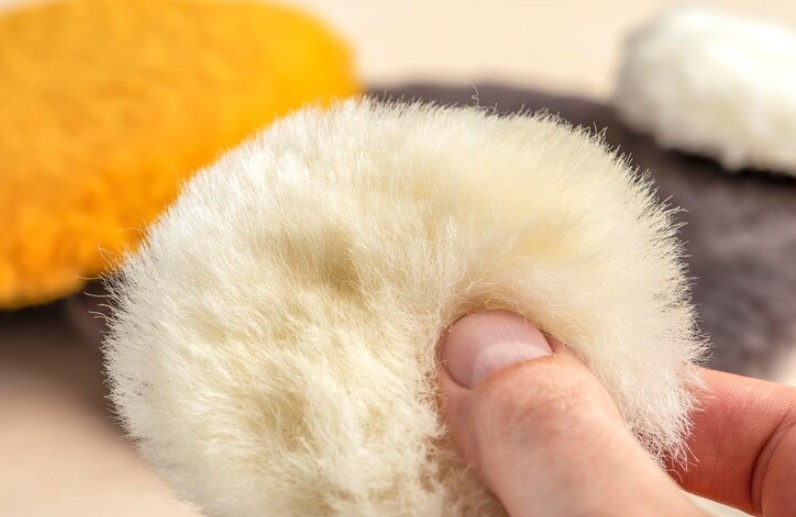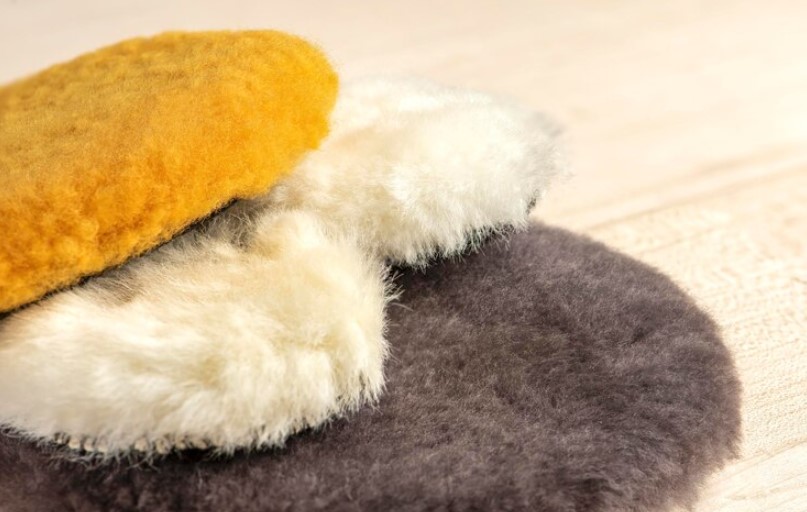Last Updated on December 26, 2022 by Leepu Da Maxim
Car buffing pads are circular pads that are useful for polishing certain hard materials. In turn, these polishing pads have different textures and combinations of certain materials. Therefore, different colors are used to better identify the use of each pad.
Key Takeaways
- Polishing pads are made from a range of materials, including foam, sponge, wool, and microfiber
- Polishing pads that are made of foam can use either closed-cell or open-cell foam
- To use a polishing pad, you have to apply the abrasive substance to the surface and then use the pad to spread and work the substance into the surface
- There are quite a few types of car buffing pads available like foam pads, microfiber pads, wool pads, rubber pads, hybrid pads, etc.
Car Buffing Pad Color Chart
| Color | Utility |
| Light orange | Eliminates surface defects, aggressive use |
| Dark grey | Elimination of defects as a second step; less aggressive |
| Red | Restoration and surface finish, low aggressiveness |
| Wool or microfiber | Hard work, medium aggression |
| White | Removes scratches from glass, not recommended for other uses |
| Black | For heavy cutting and leveling of clear coat or paint |
| Maroon | For light to medium cutting and leveling of clear coat or paint |
| Yellow | For light polishing and final finishing on softer paints. |
How Are Polishing Pads Made?

As mentioned, this element is used to treat different surfaces of a vehicle as well as other specific materials. In this case, it is possible to differentiate the different uses of the polishing pads from the colors. Beyond that, there is no uniform code that all companies use.
On the contrary, each company manufacturing these elements applies color to a certain type of polishing pad. However, here we can mention some colors normally used in most brands. For manufacturing, two types of materials are glued together to create the polishing pad.
Each of these materials can offer a particular utility. On the one hand, the backing material is included to adhere the pad to the polishing tool. Also, it can be removed very easily and is better known as Velcro. Thus, you can use a polishing machine or do the job manually.
Also, the main element is usually some kind of foam. This material will touch the paint and retain the enamel. In turn, since there are different surfaces, there are also different types of foam included here.
Thus it is also possible to find some wool or microfiber pads. In this case, these materials are attached to a foam-formed core. Besides, these two elements are also attached to the Velcro to complete the pad.
On the other hand, polishing pads that are made of foam can use either closed-cell or open-cell foam. Sometimes, it is necessary to have greater liquid absorption, and other times not. To obtain a low level of liquid absorption, closed-cell foam is used.
Conversely, when high liquid absorption is required, open-cell foam is used. In turn, each of these options will be more or less difficult to clean. Even one job may require both foam polishing pads.
So, we can outline the following elements that may or may not be used:
1. Open-cell foam
2. Closed-cell foam
3. Wool or microfiber
4. Velcro
5. Polisher
How Are Polishing Pads Used?
As mentioned, polishing pads are used for the repair and finishing of vehicle surfaces. Therefore, the most common damages to be treated are scratches, discoloration, dents, and other types of paint damage. The goal here is to keep the polished abrasives on the pad surface.
So, after that, this element is transformed into something similar to ultra-fine sandpaper. Also, it is possible to absorb the oils that are useful for this whole procedure through the porosity of the foam. To be able to count on a higher or lower level of absorption, closed or open-cell foam is used.
It is also quite common to use this tool on the curved surfaces of a vehicle. So, to do a good job in this regard, these elements are flexible and can withstand some uniform pressure. Flexibility is a very necessary aspect of these polishing pads. Otherwise, the result would be uneven on curved surfaces.
Additionally, these elements can also be used to absorb heat from a certain area. In the same way, some cold air is also applied to the surface of the vehicle to be treated.
This is even a very important aspect since the same friction during work generates increasing temperatures. So if this additional cold were not there, both the pad and the surface of the vehicle could be easily damaged.
Main Characteristics:
1. Flexible foam for curved surfaces
2. Heat-absorbing material
3. Transporting cold air to the area to be worked on
4. Provides a surface finish
5. Absorbs the liquids and oils used
What Are The Main Advantages Of Using A Polishing Pad?
These days, these items are really popular as they can provide several benefits in each work session. On the one hand, it is possible to eliminate much of the work time needed to obtain a final finish. The main purpose of a polishing pad is to remove major defects from a car’s surface.
Additionally, it is also necessary to consistently and uniformly remove the enamel that is applied to a vehicle surface. In this case, you can use a towel but better results are obtained when using a polishing pad. On the other hand, they can be placed better in a polisher and have a higher retention capacity.
Also, you will have the ability to use less enamel which of course lowers costs. In this case, the polishing abrasives can be held more evenly on the polishing pads. You can also get better results after using this tool to do much of the work.
It can also happen that the surface is accidentally scratched when you are trying to get a uniform finish. To avoid this problem, a polishing pad provides the necessary and sufficient level of safety. In other words, it is an excellent barrier between your hand and the surface you are working on.
Also, we have already mentioned that friction always generates a temperature that increases more and more. This can damage both the polishing pad itself and the surface of the vehicle. Therefore, the polishing pad is designed to remove the heat by absorbing it. Besides, it also provides some cold air to further lower the temperature.
On top of that, you will notice that the polishing pad does not expel material during the task. So, you should not worry about the remaining waste after using a polisher. Of course, this provides a result more in line with your expectations and reduces working time.
Main Benefits:
1. Reduces working time compared to other methods
2. Requires less enamel
3. Gives an even surface
4. Retains abrasives more efficiently
5. Provides an efficient safety barrier
6. Reduces heat and keeps the surface cool
7. It doesn’t leave waste after work
How Many Types Of Polishing Pads Are There?

Simply put, you can find three different types of polishing pads. Among the best-known are microfiber, wool, and foam polishing pads. Of course, each of these is used to achieve a different result. Furthermore, as mentioned, they are not only different in material but also in color.
Therefore, different colors are used for different types of polishing pads. In turn, you will have the ability to use some of these options in a polishing machine for more efficient work. So, if you have a rotary polisher or a double-action orbital polisher, you can have one of these polishing pads.
This will undoubtedly allow you to get better results and greatly reduce working time. Also, this requires the polishing pads to be larger, or at least the same diameter as the backing plate of your polishing tool. Of course, there are also different subcategories to further specify the results you want to achieve in each case.
Generally, the level of aggressiveness of each polishing pad is taken into account. Thus you can also find other names for the level of aggressiveness such as cut or correction. It is possible to use different subtypes of a polishing pad for the same job. Each of these polishing pads will be used in a specific step of the whole task.
Also, more aggressive options are often used here to remove surface defects more quickly. This is also used to remove paint from the surface of a vehicle without wasting too much time. However, using this type of polishing pad does not result in a very smooth surface finish.
On the other hand, it is also possible to use less aggressive polishing pads to do the same job. Here, however, more time will be needed to perform the same task. In the same way, the advantage is that you get a much smoother surface finish. It is also necessary to consider that the paint is removed at a less accelerated rate.
Therefore, the right way to start the task is to first use a polishing pad with a high level of aggressiveness. In this way, you will have the possibility to eliminate the most important and easy effects in this respect. As mentioned, if you want to continue the work in a proper way you will need different polishing pads.
That is why after finishing the aggressive polishing pad you can use another pad with a lower level of aggressiveness. Furthermore, it is possible to use a third polishing pad that is even less aggressive than the second one. By doing this, it is possible to achieve a much smoother and more even finish each time. You will certainly notice the difference in the end.
References:
https://www.chemicalguys.com/blogarticle?cid=blog-article-hex-logic-pad-color-code
https://www.caranddriver.com/car-accessories/a38163390/buffing-pads/

Hi, I’m Leepu Da Maxim , a dedicated car enthusiast with over 10 years of experience in this field, and I’m thrilled to share my passion and expertise with fellow car enthusiasts like you. My journey began in my hometown West Jordan, Utah, where my fascination with the mechanics and design of cars sparked at a young age. Over the years, this passion has evolved into a commitment to providing accurate, insightful, and engaging information about all things automotive through CarsAmazing .

